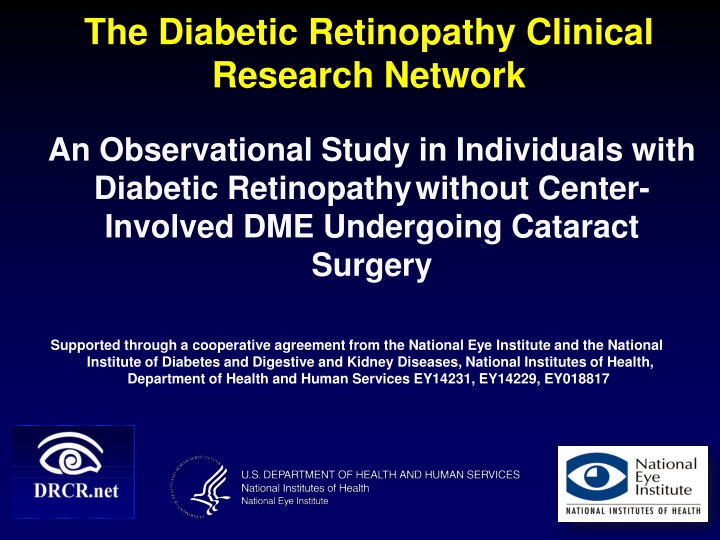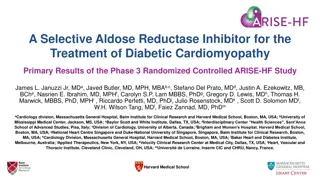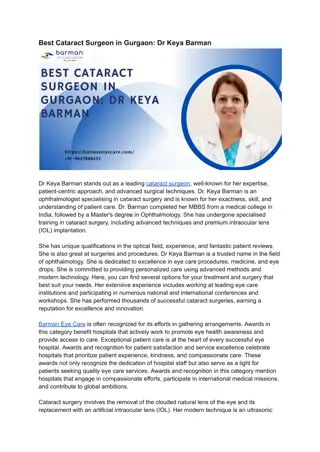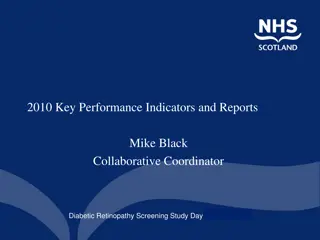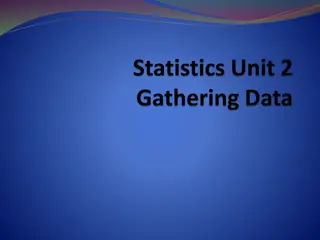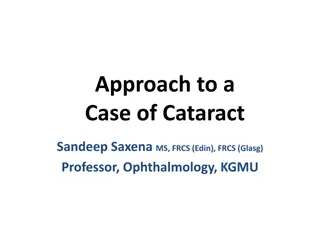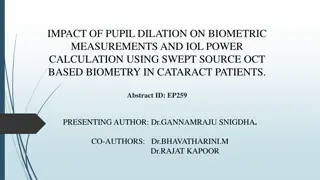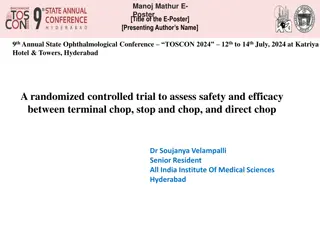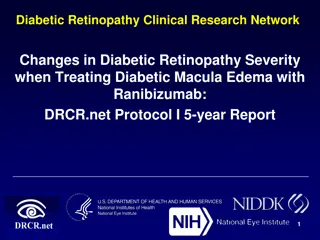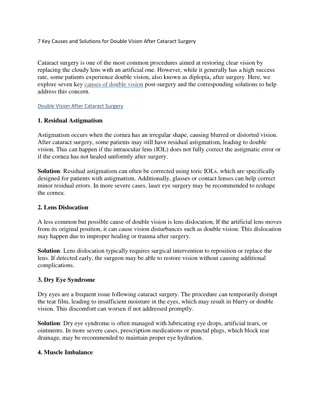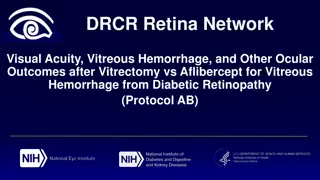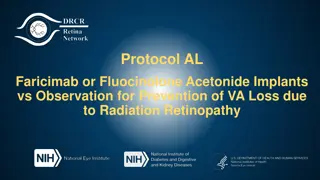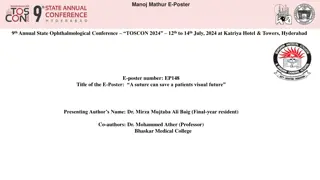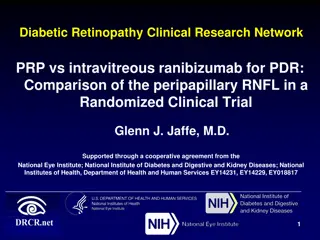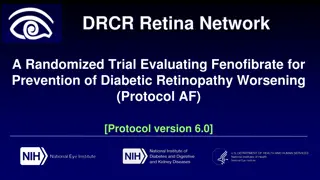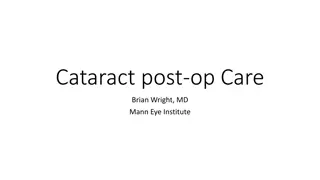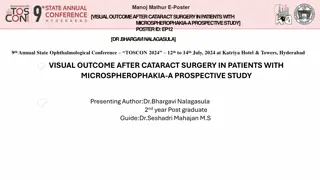Observational Study on Diabetic Retinopathy and Cataract Surgery
Limited data on visual outcomes in diabetic individuals undergoing cataract surgery prompted an observational study to estimate the incidence of macular edema post-surgery. The study involved 329 participants from multiple sites, with 14 dropouts, and achieved a high completion rate for both follow-up visits.
Download Presentation

Please find below an Image/Link to download the presentation.
The content on the website is provided AS IS for your information and personal use only. It may not be sold, licensed, or shared on other websites without obtaining consent from the author.If you encounter any issues during the download, it is possible that the publisher has removed the file from their server.
You are allowed to download the files provided on this website for personal or commercial use, subject to the condition that they are used lawfully. All files are the property of their respective owners.
The content on the website is provided AS IS for your information and personal use only. It may not be sold, licensed, or shared on other websites without obtaining consent from the author.
E N D
Presentation Transcript
The Diabetic Retinopathy Clinical Research Network An Observational Study in Individuals with Diabetic Retinopathywithout Center- Involved DME Undergoing Cataract Surgery Supported through a cooperative agreement from the National Eye Institute and the National Institute of Diabetes and Digestive and Kidney Diseases, National Institutes of Health, Department of Health and Human Services EY14231, EY14229, EY018817 1
Background There are limited data regarding visual acuity outcomes and development/exacerbation of macular edema in individuals with diabetes undergoing cataract surgery Purpose To estimate the incidence of central-involved macular edema, 16 weeks after cataract surgery in eyes with pre-operative evidence of diabetic retinopathy, in the absence of central-involved diabetic macular edema (DME) pre-operatively
Methods Prospective Multi-center Observational Study Principal Subject Eligibility Age 18 years Type 1 or type 2 diabetes One study eye meeting ocular eligibility criteria Principal Ocular Eligibility Presence of cataract for which surgery is scheduled Visual acuity light perception or better Surgery within 28 days of enrollment OCT CSF <250 m (<310 m on Spectral Domain OCT) Microaneurysms or at least mild NPDR (DR level 20 or worse) Surgery within 28 days of baseline 4 WK VISIT 16 WK VISIT Enrollment
Results 4
Primary Outcome Development of central involved macular edema at 16 weeks: eye meets 1 of the following OR OR 250 m ( 310 from SD) Plus 1 or more step increase in logOCT from baseline Two or more steps increase in logOCT from baseline Received post-op DME treatment before 16 weeks given 1 of the previous 2 criteria met 5
329 Study Participants Enrolled from 45 Sites 12 Canceled Surgeries 24 Did Not Meet Eligibility Surgery >28 days from baseline (N = 7) Ineligible baseline OCT CSF (N = 10) Non-gradable baseline OCT (N = 7) 293 Eligible 14 Dropped (5%) Death (N = 1) 278 Completed 4-week visit (95%) 279 Completed 16-week visit (95%) 6
Baseline Subject Characteristics N = 293 Median age 65 yrs Gender (%) women 58% Race (%) White African American Hispanic or Latino Other Diabetes type (%) Type I Type II Uncertain 65% 23% 9% 3% 12% 83% 6% Median diabetes duration 20 yrs Insulin use (%) Yes 67% Median HbA1c (%) 7.4 7
Baseline Ocular Characteristics N = 293 History of DME treatment Injection of steroid within 4 months or anti- VEGF within 2 months History of PRP treatment Visual Acuity ~Snellen Equivalent (median Q1,Q3) Time Domain OCT CSF Thickness Median (25th, 75th percentile (N = 281) Predefined DME Classification Based on Baseline OCT* A. No DME B. Non-Central Involved DME Present C. Non-Central Involved DME Present and Possible Central Involved DME 41% 10% 24% 20/40 (20/63, 20/32) 202 m (182 m, 219 m) 20 (7%) 103 (37%) 159 (56%) Definitions based on OCT machine gender, central subfield, inner and outer subfields. Possible central involved DME = OCT thickness value between mean and mean+2 SD of normal cohort 8
Cataract Surgery N=290 Procedure type (%) Phacoemulsification ECCE Type of IOL (%) PC IOL AC IOL Surgical complication Noted during surgery (%): Yes Mild to moderate positive vitreous pressure Anterior vitrectomy Floppy iris syndrome Small corneal abrasion Complications Noted During Follow-up Keratitis Anterior segment inflammation Posterior capsular opacification Posterior segment inflammation Endophthalmitis 98% 2% 99% 1% 2% 1 1 1 1 <1% 4% 1% 1% <1% 9
DME Treatment (N = 293) Pre-Operative Post-Operative No DME Treatment Received 257 (88%) 270 (92%) DME Treatment Received 36 (12%) 23 (8%) Anti-VEGF Only 10 13 Steroid Only 14 2 Laser Only 7 4 Anti-VEGF & Steroid 0 1 Anti-VEGF, Steroid &Laser 3 1 Anti-VEGF & Laser 1 2 Steroid & Laser 1 0 10
Eyes With Central-Involved Macular Edema at 16 weeks (%) By Baseline OCT Thickness A. B. C. No DME Non-Central Involved DME Present Non-Central Involved DME Present and Possible Central Involved DME 25 20 15 12% % 10% 10 5 0% 0 A B C N=17 N=97 N=147 11
Eyes With Central-Involved Macular Edema at 16 weeks (%) By Baseline OCT Thickness and History of DME Treatment A. B. No DME Any Edema And No History of DME Treatment Any Edema With History of DME Treatment C. 35 30 25 21% 20 %tle 15 10 4% 5 0% 0 A B C N=17* N=140 N=104 12 * 12 and 5 eyes did not have, and had history of DME treatment respectively
Eyes With Central-Involved Macular Edema at 16 weeks (%) By Baseline OCT Thickness and History of DME Treatment N 17 % 0% 95%CI 0-20% No DME* Any Edema And No History of DME Treatment Any Edema With History of DME Treatment 140 4% 2-9% 104 21% 14-30% 4 0% Recent DME Treatment Only 18 33% Recent and Old DME Treatment 82 20% Old DME Treatment Only * 12 and 5 eyes did not have, and had history of DME treatment respectively Intravitreal or peribulbar steroids or anti-VEGF therapy within the last 2 months prior to or on the day of surgery. 13
Baseline Factors Association with Central Involved Macular Edema at 16 weeks Rate of Central Involved DME Baseline Factor P-Value Total 0.38 Baseline OCT Thickness No DME Non-Central Involved DME Present Non-Central Involved DME Present and Possible Central Involved DME Baseline OCT Thickness And History of DME Treatment No DME* Any Edema And No History of DME Treatment Any Edema With History of DME Treatment VA Group Letter Score at Baseline (~Snellen equivalent) 69 (20/40 or better) 68-54 (20/50 to 20/80) 53-39 (20/100 to 20/160) 38 (20/200 or worse) 17 97 147 0% 10% 12% <0.001 17 140 104 0% 4% 21% 0.06 144 91 23 18 7% 13% 22% 17% 14 * 12 and 5 eyes did not have, and had history of DME treatment respectively
Baseline Factors Association with Central Involved Macular Edema at 16 weeks Rate of Central Involved DME Baseline Factor P-Value 0.50 Total History of PRP Yes No Diabetic Retinopathy Level Microaneurysms only Mild/moderate NPDR Severe NPDR PDR and/or prior scatter 68 208 13% 10% 0.06 54 128 14 80 4% 9% 14% 18% 15
Visual Acuity at 16 Weeks Not Developed Central involved macular edema (N = 246) Developed central involved macular edema (N = 30) Baseline VA letter score, mean SD (~ Snellen equivalent) VA letter score at 16 weeks, mean SD (~Snellen equivalent 67 15 (20/50) 60 15 (20/63) 80 11 (20/25) 69 12 (20/40) VA letter change from baseline, mean SD 13 14 9 14 55% 37% 10 letter (~ 2 line) gain, % 3% 10% 10 letter (~ 2 line) loss, % 16
Proportion of Eyes with 20/40 or Better at 16 Weeks 100 90 80 70 60 Percent 89% 67% 50 40 30 20 10 0 No CIME (N=246) Developed CIME (N=30) 17
OCT* at 16 weeks (m) Not Developed CIME (n=233) Developed CIME (n=28) 201 204 Baseline CSF, median 208 297 CSF at 16 weeks, median +8 +89 CSF change from baseline, median Relative CSF change from baseline, median +4% +41% CSF>250, increased at least 25 m from baseline, n(%) 13 (6%) 22 (79%) * From time domain machines only 18
Diabetic Retinopathy* Change At 16 Weeks 90 No CIME (N=246) 82% 80% 80 Developed CIME (N=30) 70 60 Percent 50 40 30 20 10% 10% 9% 9% 3% 3% 10 <1% <1% 0 19 * Clinical classification: None; Microaneurysms only; Mild/moderate NPDR; sever NPDR; PDR
Reading Center Classification of Macular Edema at 16-week Visit Edema Class* N=36 DME only 16 (44%) Combined CME+DME 15 (42%) CME only 5 (14%) * DME=diabetic macular edema; CME=cystoid macular edema 20
Conclusions Of eyes without definite central-involved DME prior to cataract surgery, this report suggests that rate of development of central-involved ME at 16 weeks after cataract surgery may differ by level of retinal thickness before surgery and history of DME treatment None of the 17 eyes without any edema at baseline developed central-involved ME at 16 weeks post-operatively; however sample size was small
Conclusions Eyes with non central involved DME at baseline that have not previously been treated for DME have between a 1% and 8% rate of center involved ME development 16 weeks after cataract surgery However, eyes with non central involved DME at baseline that have had prior DME treatment have a higher rate of center involved DME progression of between 13% and 28%. This information may be relevant in the management of cataract surgery in patients with diabetes 22
